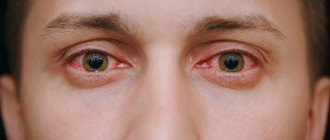Symptoms of conjunctivitis
The clinical picture of conjunctivitis has pronounced signs:
- The eyes quickly get tired from reading books and watching television, so during illness, in order to avoid complications, it is better to take care of your eyes and refuse to watch movies or work on the computer.
- Swelling of the eyelids is visible to the naked eye.
- The eye turns red, and a pink vascular network appears in some places.
- Discharges of a very different nature come out - mucus, pus, mixed with blood. Due to the secreted substance, the eyelashes of the upper and lower eyelids stick together in the morning.
If inflammation spreads to the cornea, patients complain of decreased visual acuity. The symptoms accompanying chronic conjunctivitis look like this:
- weakness, general malaise;
- migraine;
- enlarged lymph nodes.
Sometimes the doctor notices swelling of the conjunctiva, which is accompanied by hemorrhages and the formation of follicles.
Types of conjunctivitis
All forms of conjunctivitis have their own characteristics:
- Bacterial - most often occurs due to rubbing the eyes with dirty hands, dust, and can be provoked by swimming in dirty bodies of water. The bacterial format is always characterized by suppuration, pus comes out especially clearly in the morning, the eye requires thorough rinsing with tea leaves or manganese.
- If conjunctivitis is pneumococcal, gray films form on the white of the eye, which should be removed every day with a cotton swab.
- Acute epidemic Koch-Wicks is very contagious, there is a lot of pus and hemorrhage on the conjunctiva.
- Gonococcal species. It gets from the genitals with the help of hands and bed linen.
- The causative agent is diphtheria.
- Viral – everything is caused by a viral infection.
- If the larynx is severely affected, the infection moves to the mucous membrane of the organs of vision. The conjunctiva swells, multiple follicles are disturbed.
- Allergic occurs when the eyes are sensitive to allergens - tobacco smoke, flowering plants. It is not difficult to distinguish it - the disease is always accompanied by nasal congestion.
- Medicinal – appears after eye drops and ointment. Accompanied by severe itching, swelling and mucus discharged from the eyes.
Types and symptoms
The conjunctiva is a protective barrier for the organs of vision. It is the first to come into contact with external irritants, so the conjunctiva is equipped with local immunity that fights pathogenic microflora, preventing microorganisms from penetrating into the ocular structures. When the immune system is weakened or a large number of microbes attack the mucous membrane, an inflammatory process develops.
The disease mainly develops in adults who come into contact with a large number of people every day. People who use contact lenses face the problem of conjunctivitis. In this case, pathogenic microflora can penetrate the mucous membrane due to injury to the nails or fingers that occurs when the lenses are put on carelessly. Children who often rub their eyes with their hands are also susceptible to it.
The disease, both in adults and in children, has clearly defined symptoms that are so clearly manifested that it is simply impossible not to notice them.
- The conjunctiva turns red and fills with blood.
- The eyelids become swollen.
- The eyes hurt when a person looks at the light; there is a burning sensation, a stinging sensation, or the presence of a foreign object.
This symptomatology is typical for all types of conjunctivitis. But there are also distinctive features.
- Bacterial. Caused by pathogenic microorganisms. The disease is characterized by purulent discharge of a yellowish or grayish color.
- Viral. In addition to “eye” symptoms, it is supplemented by cough, sore throat, and nasal discharge.
- Fungal. It is characterized by the presence of purulent discharge, the appearance of nodules on the conjunctiva, which, after opening, turn into difficult-to-heal fistulas.
- Allergic. A distinctive feature is unbearable itching and lacrimation. Symptoms may be supplemented by a skin rash and nasal congestion.
- Contact. It develops due to prolonged rubbing of the eyes with hands, or contact with a foreign object on the conjunctiva. Characterized by severe itching and pain.
How to recover faster
With conjunctivitis, the condition of the visual organs leaves much to be desired, so it is necessary to minimize the load on the eyes to the maximum at least during intensive treatment - for a week, or preferably 2 weeks. The following can be used as supportive measures to help improve eye health:
- If you can’t take a vacation, at least organize your workplace properly. The light should fall from the left, and the computer should be located at a distance of 35-40 cm.
- Take a break of at least half an hour every 50 minutes.
- In the morning and evening before bed, make lotions from a decoction of eyebright or chamomile.
- Avoid too bright lighting.
- If you absolutely cannot do without TV, which is very undesirable during conjunctivitis, take constant breaks and do not turn off the lights. Watching movies in the absence of lighting forces sore eyes to strain even more.
- When working with reporting on a computer, zoom in on documents and enlarge the font.
- Every 2 hours, do simple eye exercises aimed at training the visual muscle.
Reviews
Larisa V., Novorossiysk Conjunctivitis is not scary, although it is very unpleasant. You wake up in the morning, your eyes are stuck together and won’t come apart. You wash endlessly all day, it’s embarrassing to go outside. But in self-isolation this disappears. At first I didn’t connect it with “corona”, the doctor suggested it and prescribed antibiotic eye drops. The eyes brightened and cleared up after just three days.
Katya Z., Ulan-Ude Fever, cough, and even eyes - this is too much. Even though my Covid was not severe, I suffered with it. My whole body hurt, and I couldn’t even watch TV or read normally. Everything is clouded, and the light hurts. Surprisingly, the conjunctivitis went away as suddenly as it appeared. I washed it with a pharmaceutical solution and took antiviral drugs, which the doctor prescribed.
Victor Olegovich, Cheboksary Red eyes, like a vampire’s, are my only symptom of Covid-19. If I hadn’t taken the test after a business trip to China, I wouldn’t have realized that this was that same terrible virus. I still had to stay at home for 2 weeks.
Gymnastics for tired eyes
If you cannot give your eyes a little vacation, then to relieve the painful condition and reduce inflammation of the mucous membranes with conjunctivitis, it is recommended to regularly do the following exercises:
- Rotate your eyes, describing a circle clockwise, and then counterclockwise. The exercise must be done 5 times in each direction.
- Rapid blinking promotes relaxation of the eyes and better blood circulation.
- Draw a square with your gaze, also in different directions.
- Blink again.
- Move your eyes from left to right, and then from right to left, 5 times in each direction.
- Move your eyes from top to bottom and back again.
- Repeat fast blinking.
- Move your visual organs diagonally.
- Bring your eyes to the bridge of your nose several times.
- Take a far and near look at objects located far and near.
- Use your eyes to describe the figure eight or infinity sign used in mathematical notation.
- Blink frequently during the day; infrequent blinking leads to dry eyes and even more inflammation.
The best vitamins for eyes
In the fight against chronic conjunctivitis, along with restrictions on watching TV and working on the computer, eye vitamins, which are contained in food and special medicinal complexes, remain effective:
- With a lack of vitamin A, visual acuity decreases, and adaptation in the dark leaves much to be desired.
- Vitamin C – helps strengthen the walls of the blood vessels of the eyes.
- Vitamin E - strengthens the structure of tissue membranes that protect the organs of vision from exposure to excessively bright light and ultraviolet rays.
The most beneficial substances that strengthen vision and are responsible for eye immunity are found in blueberries and beets.
Conjunctivitis is an inflammatory ophthalmological disease that can be viral, allergic, bacterial, or fungal in nature .
Symptoms and a number of studies help the doctor quickly make a diagnosis and prescribe treatment.
In addition to drug therapy, you will also need to observe precautions that are associated with reducing eye strain.
Nowadays, the main source of eye strain is the computer.
Is it possible to work at a computer if conjunctivitis begins?
They do not have the opportunity to avoid working with gadgets every day, but it is important for a person to know whether he is taking risks or not.
Doctors say that at the first symptoms of inflammation, it is better to refuse to work or play on the computer , because you first need to find out the nature of the disease.
If the disease appears for the first time, and the person has not yet consulted a doctor, it cannot be said at all that we are talking about conjunctivitis.
Therefore, tearing, dryness and discomfort in the eyes should be a reason to refuse to work at the computer, at least until examination and diagnosis.
Eye strain caused by working at a computer contributes to the rapid progression of conjunctivitis, although the prohibition cannot be called strict .
If your profession is related to a computer , and there is no opportunity to go on vacation, then you can continue your usual activities, taking precautions .
But it’s better not to use the “machine” for games and mindlessly flipping through the tape.
Causes
Currently, conjunctivitis is a symptom of Covid, but it can begin for many other reasons - bacterial, fungal, allergic, autoimmune and traumatic origin.
In adults, inflammation of the eye sclera occurs against the background of chronic blepharitis, dry eye syndrome and inflammation of the lacrimal sacs (dacryocystitis). In children, it often occurs with otitis, sinusitis and other pathologies of the nasopharynx.
The US Academy of Ophthalmology made the statement based on data from medical groups. It says that conjunctivitis with coronavirus is a new symptom.
According to the theory put forward, the molecules through which infection is transmitted settle on the mucous membrane of the eyes. And they get there along with the air containing tiny droplets of nasal secretions of the virus carrier.
Viral particles - virions - are able to maintain their viability in the air and on various surfaces. Depending on the type of external environment, the duration of the life cycle can reach a week or more.
In other words, we are not just talking about direct transmission of infection. One should also take into account the indirect entry of virions into healthy people, who can introduce them into the body by touching their face with dirty hands. Therefore, prevention recommendations include both thorough hand washing and disinfection of objects.
Everyone is already accustomed to seeing doctors wearing protective glasses: this is no coincidence, because the virus also penetrates the mucous membranes of the eyes, causing inflammation
Taking this aspect into account, medical personnel are recommended to wear protective glasses when working with patients, and not just a mask for respiratory protection. That is, the new symptom made adjustments to preventive measures and made them more stringent.
Fact! According to available data, coronavirus conjunctivitis is observed in 5-7% of patients.
Is it possible to work while treating a disease?
When the diagnosis is made and treatment is prescribed, the time comes for a more categorical “no”.
A complication of conjunctivitis is keratitis, which can lead to vision loss. This disease most often occurs among confident PC users.
Otherwise, the duration of treatment will increase and the effectiveness may decrease.
Medicines alleviate the condition and relieve the symptoms of conjunctivitis, but during exercise, a “rollback” occurs, and the eyes are again subjected to a serious test.
Is it possible to watch TV when you are sick?
The attitude towards TV is the same as towards the computer..
If you have an allergic form of the disease, you are allowed to work at the computer and watch TV.
If a person has poor eyesight, they may have to squint or sit closer to the TV, which further aggravates the problem.
There is no urgent need to watch TV, because this is a leisure option, not work, so during the treatment of conjunctivitis it is better to refuse this type of entertainment or follow all precautions .
Prevention recommendations
Conjunctivitis requires a comprehensive therapeutic approach.
During prolonged intense eye work, which is typical for those who sit in front of a monitor all day, a person blinks less often.
As a result, the amount of tear fluid decreases and the eye membranes dry out.
And these conditions are favorable for the spread of the inflammatory process.
A characteristic symptom of conjunctivitis is photophobia, so looking at a screen can even cause pain.
If it is not possible to refuse to work at the computer or watch TV, you should follow special rules:
- Every 30 minutes you need to take at least a 10-minute break and do special exercises for the eyes.
- The work area must have proper lighting : the window must not be located behind the monitor or directly behind the person’s back, and the lights must not be turned off when watching TV.
- The distance from the eyes to the monitor should be at least 40 cm.
- After working at the computer or watching TV, it is recommended to use any folk method to relieve eye strain . Apply raw potatoes, cucumber, tea bags to your eyes, make chamomile lotions, a compress of parsley with sour cream, wash with cold water.
- During monotonous work at the computer, it is better to increase the font.
- If there are visual impairments (myopia, farsightedness, astigmatism) and the doctor recommended correction with glasses or contact lenses, they should always be used.
How not to get infected
Infectious (bacterial and viral) conjunctivitis is easily transmitted. You can become infected through household items or simply by being in the same room with a sick person.
Try to avoid contact with the sick person as much as possible. Maintain hygiene: do not use only a towel, wash your hands often with soap, do not touch the patient’s eye drops - they should be thrown away immediately after use. Store the patient's personal utensils and hygiene items separately. A face towel for a person with conjunctivitis must be changed daily, after ironing it. The same should be done with the pillowcase. Do wet cleaning of the room regularly.
Useful video
From this video you will learn more about conjunctivitis:
Conjunctivitis has become a common disease in recent years , and often the provoking factor is prolonged use of gadgets .
When the first signs of conjunctivitis appear, you should immediately consult a doctor , and during an exacerbation it is advisable to reduce eye strain as much as possible.
The less time a person spends at the computer or watching TV, the faster the recovery and the lower the risk of complications.
Many people who have a chronic disease such as conjunctivitis are wondering: is it possible to work at a computer when it worsens? Look for the answer in our information article, as well as recommendations for treatment and prevention.
How long does it take to treat conjunctivitis?
Conjunctivitis is one of the most common ophthalmological diseases, which both adults and children have probably encountered at least once in their lives. The disease itself is not severe and does not pose a direct threat to human health. However, it is extremely unpleasant and can greatly ruin plans, which is always upsetting. Therefore, if such a diagnosis is made, one of the most common questions among adults is: how long does conjunctivitis last and whether sick leave is given for this period. Mothers are especially interested in this question if conjunctivitis is found in children, because it is very difficult to look at a suffering baby. The duration of the disease is determined, first of all, by its form and the timeliness of seeking medical attention. But there are several more important nuances that determine how many days it takes for conjunctivitis to go away. What is conjunctivitis, what forms it comes in, what are the features of treatment - below.
What is conjunctivitis? Characteristics of the disease
Experts call conjunctivitis a disease that is characterized by an inflammatory process of the mucous membrane of the eye (conjunctiva). Most often, conjunctivitis occurs due to neglect of basic personal hygiene rules. But sometimes another pathogen may be the cause. In this regard, conjunctivitis occurs:
- infectious, caused by bacteria, infections, viruses, chlamydia and even fungi;
- non-infectious, provoked by an allergic reaction. Moreover, such a reaction can be caused by anything: chemicals or external irritants, which also contribute to inflammation of the mucous membranes.
What do the doctor's say
If conjunctivitis begins, it can seriously affect visual acuity. It is better for adults not to drive until the inflammation goes away.
According to doctors, the mucous membranes of the eyes are a favorable environment for Sars-CoV-2, since its acidity pH is identical to the pH of tear fluid. This is why, when it gets into the eyes, the virus lingers there.
In patients with conjunctivitis, Covid can be diagnosed by taking biomaterial directly from the mucous membrane of the eyes. Typically, a PCR test is done on the basis of nasal mucus taken from the nasopharynx.
The new coronavirus infection, as a rule, affects “weak spots”: if the patient’s kidneys are not working well, then it will hit them, weakened blood vessels can cause a stroke. It’s the same with the eyes - if there are problems, then the disease can lead to the development of eye pathology.
What are the symptoms of conjunctivitis?
How to navigate and understand whether you have conjunctivitis or not? Looking ahead, we note that under no circumstances should you begin the treatment process on your own. If, based on the symptoms listed below, it becomes clear that you are dealing with this particular disease, immediately contact a specialist. Do not delay, otherwise conjunctivitis may become chronic.
So, ophthalmologists talk about the following clinical picture of conjunctivitis:
- rapid eye fatigue, especially when reading or watching TV, when working at the computer;
- there is swelling of the eyelids;
- there is severe redness of the eyes;
- specific mucous or purulent discharge from the eyes;
- sensation of a foreign body in the eye, photophobia, blepharospasm.
In some cases, patients also complain of severe weakness, migraines, enlarged lymph nodes and increased body temperature.
At what stage does it occur?
Conjunctivitis is most often one of the first signs of infection, along with an increase in temperature. In the first 4 days, you may also experience a dry cough, weakness and body aches. Some patients complain of indigestion and loss of smell.
Former patients felt shortness of breath on days 5-6, and for many this was the peak time when symptoms were most severe. On days 8-9, respiratory failure develops if the disease is severe.
Starting from day 12, the temperature decreases, the condition improves, and after 2-3 weeks complete recovery occurs.
Fact! Doctors call cough a secondary symptom, and even after discharge from the hospital it may continue for some time.
Is it possible to work at a computer with conjunctivitis?
The question “is it possible to work at a computer” is perhaps one of the most common among patients who have experienced inflammation of the eye mucosa. At the moment, it is difficult to imagine a person who would not work behind a monitor, or whose activities were not associated with the active use of various gadgets. Experts recommend limiting the load on the visual organs during treatment, for at least one to two weeks. If it is not possible to completely exclude the computer during illness, the following rules should be followed:
- the computer should be at least 40 centimeters from the eyes, preferably on the left;
- you should take half-hour breaks every hour while working;
- In the morning and before going to bed, do not forget about lotions made from herbal decoctions (they are also prescribed by the doctor as a treatment);
- If you cannot limit yourself to watching TV or constantly interact with gadgets, then be sure to use additional lighting. This will allow your eyes to strain less;
- if your work involves numbers or letters, then in the computer settings you should increase the scale of all font groups;
- Every two hours you should perform gymnastics for the muscles of the visual organs.











